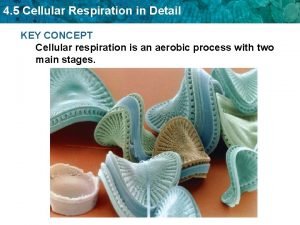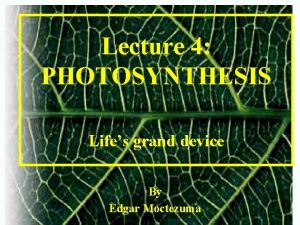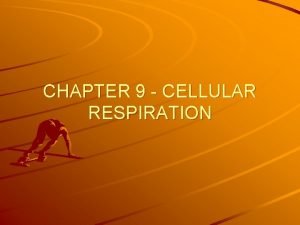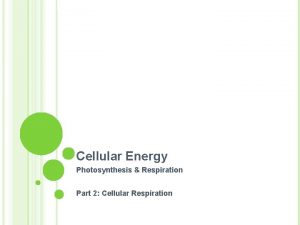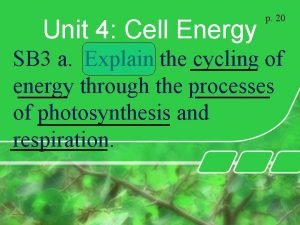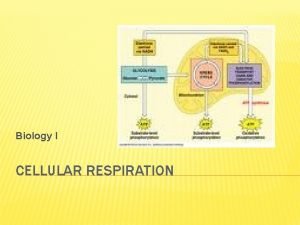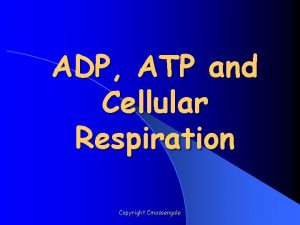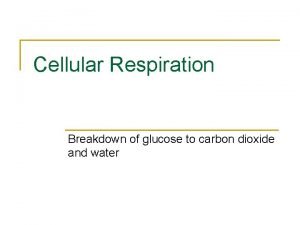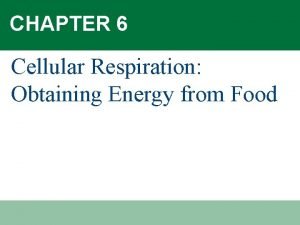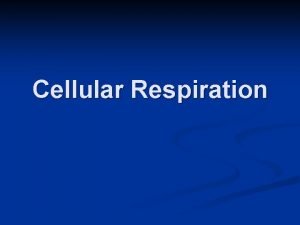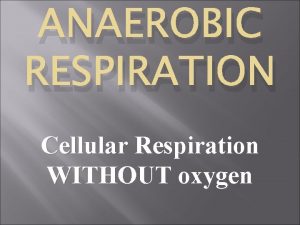Cellular Respiration What is Cellular Respiration A Famous












- Slides: 12

Cellular Respiration.

What is Cellular Respiration? ? ? �A Famous scientist once said “Cellular Respiration is in my opinion, the most important biochemical reaction in Heterotrophic systems” Me (Just now) �Cellular Respiration is the mechanism in which we derive energy from what we eat. �All Heterotrophs use cellular respiration to obtain energy. �Most Autotrophs use photosynthesis to obtain energy. �Cellular respiration is the inverse of photosynthesis.

Photosynthesis vs. Cellular Respiration Photosynthesis Cellular Respiration

Cellular Respiration The process of Cellular Respiration occurs in 3 -4 steps. 1) Glycolysis 2) Krebs Cycle 3) Eletron Transport Chain

1) Glycolysis � Gluc- comes from the Greek word meaning Sweet. � Cose- we put at the end of words to signify Sugars. � Lyses- means to break down. � This process occurs in the cell’s Cytoplasm. � Glycolysis- is the process in which one molecule of glucose (a 6 carbon compound) is broken in half, producing two molecules of pyruvic acid (a 3 -carbon compound) , 2 ATPs and 2 NADH bi products. � This is an Anaerobic Process (no oxygen required) this means glycolysis can provide energy to the cell when oxygen is not available. Even though glycolysis is an energy-releasing process, the cell needs to put in a little energy to get things going. At the pathway's beginning, 2 molecules of ATP are used up. Although the cell puts 2 ATP molecules to get glycolysis going, when glycolysis is complete, 4 ATP molecules have been produced. This gives the cell a net gain of 2 ATP molecules. Catalyzed reactions produce NADH holds the electrons until they can be transferred to other molecules. By doing this, NAD+ helps to pass energy from glucose to other pathways in the cell.

Problems with Glycolysis �Although the energy production from glycolysis is small, 2 Net ATP’s are formed (used 2 ATP’s and generated 4) and 2 NADH, the process is so fast that cells can produce thousands of ATP molecules in just a few milliseconds. �However, when a cell generates large amounts of ATP from glycolysis, it runs into a problem. In just a few seconds, all of the cell's available NAD+ molecules are filled up with electrons. Without NAD+, the cell cannot keep glycolysis going, and ATP production stops.

2) Kreb’s Cycle �The Krebs cycle is named after Hans Krebs, the British biochemist who demonstrated its existence in 1937. �To extract the rest of the energy stored in electrons from glycolysis, the cell turns to one of the world's most powerful electron acceptors --�Oxygen!!! �Oxygen is required for the final steps of cellular respiration. Because the pathways of cellular respiration require oxygen, they are said to be aerobic. �This process occurs in the matrix of mitochondria.

Kreb’s Cycle preparation Pyruvic Acid Oxidation As we remember from glycolysis glucose was lysed to make 2 pyruvic acid molecules. Each pyruvic acid molecules is oxidized meaning 1 carbon is taken away. All of this is catalysed by Enzymes !! Proteins that bring things together in the right way so they can react. At the end of pyruvic acid oxidation 1 NADH is Produced This makes a 2 carbon molecules called Acetyl Co. A. This process also reduces NAD+ to NADH

Once Acetyl Co. A and NADH are produced the Kreb’s Cycle can begin! Remember before Kreb’s cycle pyruvate is oxidized and forms 2 carbon Acetyl Co. A and produces 1 NADH. 1 FADH and 1 NADH are produced and the Krebs Cycle starts all over again. Next Acetyl Co. A merges with a 4 carbon molecule to form 6 carbon Citric Acid. 2 Carbon molecule + 4 carbon molecule = 6 carbon Citric Acid. 1 carbon is sliced off and 1 NAD+ is reduced to NADH. Tada!!! We are back to a 4 Carbon Molecule : D Le’s add them up! During this process 1 ATP and 1 NADH are produced. What is happening to the Carbon? ? ? It becomes 1 CO NADH 2 when it attaches to From Pyruvate oxygen they leave. Oxidation your system 3 NADH Now we are left with Every a 5 carbon molecule as you exhale. time the Krebs 1 ATP and again a carbon molecule is sliced off. cycle runs 1 you generate 3 molecules FADH 2 of CO 2 for From each. Krebs pyruvate. (x 2 for each Pyruvic acid) FADH and NADH are converted to ATP later in the Electron Transport Chain

Electron Transport Chain � The Krebs cycle generates high-energy compounds (10 NADH and 2 FADH 2 )that are passed to. The electrons are then passed from those carriers to the Electron Transport Chain. � The electron transport chain- uses the high-energy electrons from the Krebs cycle to convert ADP into ATP. � In Eukaryotes, the electron transport chain is composed of a series of carrier proteins located in the inner membrane of the Mitochondrion. � In prokaryotes, the same chain are in the Cell Membrane. � On average the ETC produces 3 molecules of ATP from each molecule of NADH (30 ATP) and 1 molecule of ATP from each FADH (2 ATP) produced in the Kreb’s Cycle.

� Every time a pair of high-energy electrons moves down the electron transport chain, the energy is used to move H+ ions across the membrane. These ions then rush back across the membrane, producing enough force to spin the ATP synthase and generate enormous amounts of ATP.

So lets count. . . 2 ATP 2 NADH From Glycolysis + 2 NADH From Oxidation of Pyruvate + 6 NADH 2 ATP 2 FADH From Krebs Electron Transport System (Converts NADH and FADH to ATP) 10 NADH x 3 = 30 ATPs 2 FADH x 2 = 4 ATPs 4 ATP ____________ 38 ATPs Total!!!
 Concept 5 cellular respiration
Concept 5 cellular respiration Respiration reaction
Respiration reaction Cellular respiration releases
Cellular respiration releases Cellular respiration organelle
Cellular respiration organelle Chemiosmosis steps
Chemiosmosis steps Concept map cellular respiration
Concept map cellular respiration Cellular respiration
Cellular respiration What is the word equation for cellular respiration
What is the word equation for cellular respiration Cellular respiration fact
Cellular respiration fact Aerobic respiration
Aerobic respiration Coenzymes in cellular respiration
Coenzymes in cellular respiration Overview of cellular respiration
Overview of cellular respiration Cellular respiration obtaining energy from food
Cellular respiration obtaining energy from food
